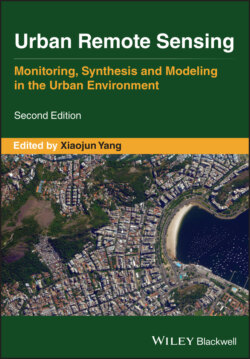Читать книгу Urban Remote Sensing - Группа авторов - Страница 13
Оглавление
Preface
The first edition of Urban Remote Sensing: Monitoring, Synthesis and Modeling in the Urban Environment published in 2011was primarily an outcome of my decade‐long efforts promoting urban remote sensing research through organizing thematic paper sessions at the annual meetings of the American Association of Geographers (AAG). It is the first book written with a broad vision of urban remote sensing that draws upon multiple disciplines and the integration of remote sensing with relevant geospatial data and technologies. The book covered a variety of topics extending beyond urban feature extraction and into socioeconomic and environmental analyses and predictive modeling of urbanization. It contrasts considerably in such a treatment with other dedicated books on urban remote sensing, which are largely restricted on urban feature extraction and land use interpretation. In addition, the book has been translated into Chinese and was published by China’s Higher Education Press in 2014.
Over the past decade, we have witnessed evolving innovations in sensors, technologies, and theories in the broad arena of Earth Observation, which enable critical information to be developed through remote sensing in support of urban management activities and the scientific research on socio‐environmental dynamics and sustainability. Specifically, the availability of openly accessed satellite image archives since the late 2000s, coupled with the progression of high‐computing and cloud computing infrastructures, prompts the surge of multi‐temporal image analyses moving beyond fast‐paced change detection (such as land conversions) and into monitoring of continuous land use activities with slower change rates (such as land modifications). New or emergent platforms or systems, such as unmanned aerial systems and social sensing, provide spatial flexibility in urban mapping and new opportunities for understanding the changing urban environment. The advancement of artificial intelligence technology beyond shallow learning algorithms and into deep learning models helps discover the intricate structure in large remote sensor datasets, bringing about breakthroughs in image understanding over complex urban environments. Last, integrating remote sensing with relevant geospatial data and technologies supports innovative urban applications moving beyond observing spatiotemporal patterns and into analyzing socio‐environmental dynamics, and into pursuing toward urban sustainability.
The time is ripe for a new edition on urban remote sensing after one decade of publishing the first version. While continuing research on some critical issues identified in the earlier volume is also examined, this new edition focuses on a variety of essential and emerging research areas in urban remote sensing including sensors, techniques, and applications. The book is divided into five parts beginning with an introductory part discussing the rationale and motivation leading to the publication of the new volume. The second part examines advanced and emerging platforms or systems, such as unmanned aircraft systems and social sensing, which provide new opportunities for urban studies. The third part discusses some emerging remote sensing and machine learning techniques, such as deep learning and cloud computing infrastructures, for urban attribute extraction. The fourth part presents several innovative socioeconomic applications through remote sensing, such as urban slum mapping and urban conflict damage monitoring. The last part showcases some latest progress in the synergistic use of remote sensing and relevant geospatial techniques for urban environmental applications, which are related to such issues as man‐made carbon dioxide emissions, urban microclimate, air pollution, urban green infrastructure, and urban sustainability.
This book is the result of extensive research by interdisciplinary experts, and will appeal to students, researchers, and professionals dealing with not only remote sensing, geographic information systems, and geocomputation but also urban planning, geography, environmental science, global change science, and sustainability science. It is worth noting that the book project has spanned almost the entire period of the global coronavirus pandemic by now. The virus (COVID‐19) imposes tremendous impacts on our daily life challenging the project completion. I am very grateful to all of those who contributed a paper and revised their paper one or more times and those who reviewed a paper according to my requests and timelines, particularly during these unusual times. The group of reviewers who contributed their time, talents, and energies is listed here: Jongnam Choi, Kaveh Deilami, Fabio Dell’Acqua, Chengbin Deng, Song Gao, Fang‐Ying Gong, Stefanos Georganos, Zhiyong Hu, Feilin Lai, Noam Levin, Ting Liu, Yang Shao, Di Shi, José L. Silván‐Cárdenas, Paul C. Sutton, Jill C. Trepanier, Changshan Wu, Junjun Yin, Yihong Yuan, and Caiyun Zhang. I wish to express my sincere gratitude to several staff members at John Wiley & Sons Ltd, especially Andrew Harrison (Acquisition Editor) who waked me up to the idea of a second edition, Rosie Hayden (Managing Editor), Antony Sami (Project Editor), and Shyamala Venkateswaran (Content Refinement Specialist) who helped me in many ways. Acknowledgments are due to my late mother Jiazhen Zhang (1941–2021), my father Chuangyao Yang, my wife Debbie (Xiaode) Deng, my son Lee Yang, and my doggy “Nana” for their patience and love, to Dr. James O. Wheeler (1938–2010) who inspired me to pursue my passion on the urban environment, and to Dr. Chor Pang (C.P.) Lo (1939–2007) who offered brilliant guidance and boundless encouragement over many years of my professional careers.
Xiaojun Yang
Tallahassee, Florida, USA
2021
